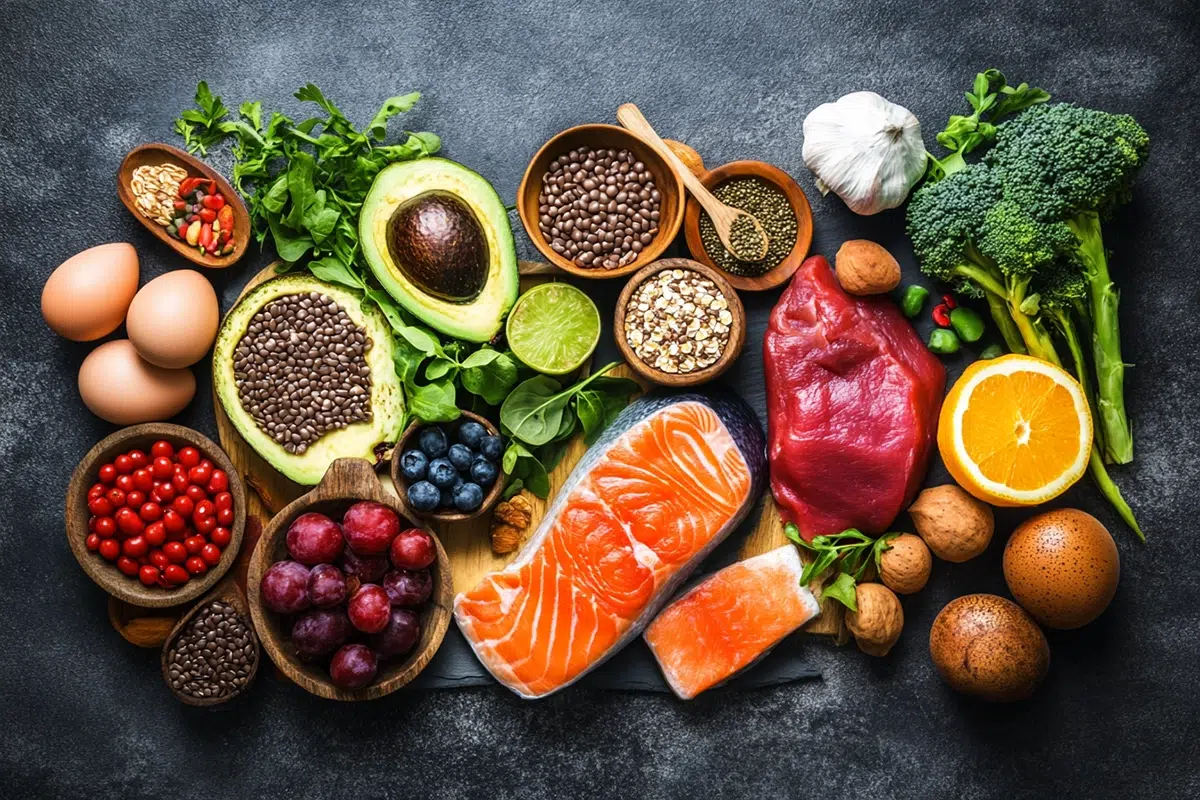Show summary Hide summary

Definition: What is a macronutrient?
Macronutrients are the main components of food. The role of these nutrients is to provide the body with energy, in the form of calories. Macronutrients are also essential for the proper functioning of our vital functions. They should not, however, be confused with micronutrients, which are vitamins, minerals and trace elements!
Macronutrients fall into three main families:
– Lipids or fats
– Proteins
– Carbohydrates
The right balance between these macronutrients plays an essential role in your health goals, whether you want to lose weight, build muscle mass or simply maintain a healthy lifestyle. So it’s important to understand their role and incorporate them in a balanced way into our daily diet.
How much energy do macronutrients provide?
From an energy point of view, fats are much more calorific than proteins or carbohydrates. In fact, it’s useful to know that :
- 1 gram of fat = 9 kcal
- 1 gram of protein = 4 kcal
- 1 gram of carbohydrate = 4 kcal
How should macronutrients be distributed in your diet?
A healthy, balanced diet should contain approximately :
- 40-55% carbohydrates
- 35-40 % fat
- 15-25% protein
Of course, these rates are theoretical and vary according to your needs and objectives.
To find out your daily macronutrient requirements, use our macronutrient calculator: What are your daily macronutrient requirements?
Macronutrients in detail
To find out more about these macronutrients, click on each image below.
MACRONUTRIENTS
Proteins

What are proteins?
The term ‘protein’ derives from the Greek word ‘proteos’, meaning ‘first place’ or ‘primary’. Proteins are essential macronutrients found in many of the foods we eat, such as eggs, meat, fish and pulses. They are made up of 20 amino acids that contribute to the formation of the thousands of different proteins present in our bodies, and are often described as the ‘building blocks’ of life.
Of these 20 amino acids :
- 9 are said to be “essential” (tryptophan, lysine, methionine, phenylalanine, threonine, valine, leucine, isoleucine and histidine) which means that they must be provided by foods called “protein foods”.
- The other 11 are called “non-essential” because they can be manufactured by the human body from essential amino acids.
Proteins: their function in the body and their health benefits
Proteins play a fundamental role in the functioning of our body. Their main function is to contribute to the growth, repair and maintenance of body tissues. Every cell and organ in our body contains proteins, which are involved in various vital functions.
For example, proteins are essential for muscle building, enzyme regulation, nutrient transport and immune defence. They also play a crucial role in hormone production, metabolism regulation and the transmission of nerve signals.
In short, proteins are truly our body’s ‘workers’, working tirelessly to ensure its proper functioning and overall health.
Which proteins to choose?
The choice of protein depends on your nutritional needs and dietary preferences. Here are some common options:
- Animal proteins: Lean meats (such as chicken, turkey and fish) are excellent sources of animal protein. Eggs, dairy products (such as yoghurt and cheese) and meat products (such as ham) are also options. However, it’s important to choose lean sources to limit your intake of saturated fats.
- Plant proteins: Legumes (such as beans, chickpeas and lentils), nuts and seeds (such as almonds, cashews and chia seeds) and soya products (such as tofu and tempeh) are excellent sources of plant protein. They are often richer in fibre and health-giving nutrients.
- Alternative proteins: More and more plant-based alternative proteins, such as meat substitutes made from pea or soya protein, are available on the market. They may be an option for those looking to reduce their meat intake while maintaining an adequate protein intake.
The choice of protein will depend on your diet, your nutritional goals and your personal preferences. It is advisable to vary your protein sources to benefit from a full range of amino acids and nutrients essential for optimal health. Consult a nutrition professional or dietician for recommendations tailored to your specific needs.
Carbohydrates

What are carbohydrates?
Carbohydrates are macronutrients in the same way as fats and proteins. They contain carbon, hydrogen and oxygen, hence their common name of “carbohydrates”, although they are more often referred to as “sugars”. They may be assimilable, in the case of simple and complex carbohydrates, or non-assimilable in the case of fibre (fibre also falls into the carbohydrate category).
Surprisingly, and often ignored by the general public, carbohydrates, unlike fats and proteins, are not essential since the body is able to manufacture them from other macronutrients.
Carbohydrates: their function in the body and their health benefits
Carbohydrates have an energy role, like fats, but unlike fats, the energy provided to the body can be used quickly. This fuel is used for brain function, but is also involved in muscle contraction.
As for fibre, it plays a major role in weight balance, regulating transit and cholesterol levels, and much more besides.
Although carbohydrates are an excellent fuel for active people, you need to choose your carbohydrates carefully to avoid storing them easily and therefore putting on weight.
Which carbohydrates to choose?
Carbohydrate foods act differently in the blood. Some raise blood sugar levels quickly, while others release sugar slowly into the bloodstream. The glycaemic index classifies carbohydrates according to their ability to raise blood sugar levels.
The quality of a carbohydrate food will therefore depend on its GI value. The higher a food’s GI, the more it raises blood sugar levels. Our body, and more specifically the pancreas, will react to this surge in blood sugar by secreting a hormone called insulin. This spike in insulin helps to control the massive influx of sugar into the bloodstream, in other words, to regulate blood sugar levels (to keep them at a normal level).
Foods are divided into 3 categories: low GI (<55), moderate GI (between 55 and 70) and high GI (>70).
so it’s important to choose carbohydrate foods that don’t cause major insulin spikes, i.e. those with a low GI (<55).
In general, the best carbohydrate foods are fresh and raw fruit, vegetables, pulses, gluten-free, wholegrain and/or semi-complete cereals (their GI is low, especially if cooked al dente), potatoes and sweet potatoes (avoid frying, boiling potatoes without the skin, mashing) and chestnuts.
For sweetening, consider honey, which contains antibiotics and other active ingredients. Eaten raw, it promotes healthy intestinal flora and has anti-inflammatory and antioxidant properties. Refined white sugar, on the other hand, is harmful to health because of its high glycaemic index and lack of nutritional value.
Lipids

What are lipids?
Lipids, also known as fats, are the most energy-rich macronutrient. In fact, one gram of fat provides 9 calories, more than double the amount of calories provided by carbohydrates and proteins.
Fats differ in the structure of their components, known as “fatty acids”. According to their biochemical structure, we can classify fats into 4 main families.
The 4 families of lipids :
- Polyunsaturated fatty acids
- Monounsaturated fatty acids
- Saturated fatty acids
- Trans fatty acids
Lipids: their function in the body and their health benefits
Often demonised for their harmful effects on weight and health, lipids are nonetheless essential for the body to function properly. And since our bodies cannot manufacture them, it is important to ensure that we have a sufficient intake of quality fats.
They are essential for our daily activities (sport, regulating body temperature, etc.) and when we consume more fat than we need, it is stored in fat cells.
But lipids don’t just provide energy. Lipids are very important for our health because they form the structure of our cell membranes. All the cells in our body need them to function properly. In particular, they enable vitamins A, D, E and K to be transported and assimilated by the body. Lipids are essential for our brain, heart and arteries. These fats also contribute to the production of steroidal sex hormones.
So even if you want to lose weight, it’s important not to cut them out of your diet and to continue eating fats… but not just any fats!
Which fats to choose?
Knowing the different types of fat can be essential for staying healthy or losing weight! So let’s take a look at the classification of these dietary fats.
Polyunsaturated fatty acids: the best fats!
Polyunsaturated fats are so-called “essential” fats. The body absolutely needs them for the growth and physiological functions of its cells. And as our bodies are unable to manufacture or substitute them, these fats must be provided by our diet.
There are two main families of polyunsaturated fatty acids:
- Omega 6: contributes to the immune system and heart health. They ensure the plasticity and elasticity of the skin. A deficiency in Omega 6 can therefore lead to skin dryness, loss of suppleness and fragility.
- Omega 3: some studies have highlighted the benefits of omega 3 in brain functions such as memory, anxiety and depression.
Monounsaturated fatty acids: eat them regularly!
The main component of monounsaturated fatty acids is oleic acid (a type of omega 9).
These fats are not considered essential, although they play an active role in biological functions. Their main source is vegetable. You can find them in olive oil, macadamia oil, oleic sunflower oil, avocados and oilseeds.
Trans fatty acids to avoid
Based on current knowledge, according to the Anses, the ‘natural’ trans fatty acids present in meat, milk and dairy products from ruminant animals do not appear to pose any health risks. On the other hand, ‘technological’ trans-fatty acids (found in ready-made meals, fast food, crisps, confectionery, pastries and breakfast cereals) are associated with an increase in cardiovascular disease and ‘bad’ cholesterol levels. So avoid them if you want to stay healthy!
Saturated fatty acids (SFA) in moderation
Only the following sources: lauric, myristic and palmitic acids present health risks if consumed in excess. They can be found particularly in coconut oil, copra oil, palm oil, vegetable fats used for frying bread, certain industrial products, etc. In fact, these types of fatty acid are atherogenic, meaning that they encourage the formation of atheromatous plaque on artery walls. They can also be responsible for the formation of blood clots and an increase in blood cholesterol levels. They therefore increase the risk of cardiovascular disease (myocardial infarction, atherosclerosis, stroke, etc.).
So, according to the Anses, to avoid risks to the body, the level of saturated fatty acids should not exceed 12% of calories per day and 8% for lauric, myristic and palmitic acids.
As you can see, the idea is not to ban saturated fatty acids, but to consume them sparingly, giving preference to certain sources that are not harmful to health.
Fibres

What is fibre?
Dietary fibre is a member of the carbohydrate family. They are polysaccharides (complex sugars) which, unlike carbohydrates, are not digested by digestive enzymes and are therefore not absorbed. As a result, unlike other carbohydrates, fibre does not provide our body with energy.
Fibre: its function in the body and its health benefits
Fibre plays a major role in weight balance, regulating transit and cholesterol levels, and much more. Their benefits differ depending on whether they are soluble or insoluble, as we shall see below.
Soluble fibre: what are its benefits and where can I find it?
Soluble fibre is so called because it dissolves in water to form a viscous gel in the intestine.
Thanks to this property, soluble fibre has 6 benefits:
- Soluble fibre increases the feeling of satiety and reduces food intake
- It prevents cravings
- It detoxifies
- Preserves the intestinal mucosa, the seat of immunity and a pillar of overall health
- They promote intestinal transit
Soluble fibre is found in plants rich in pectin, alginate, beta-glucan, mucilage and gum, such as fruit, vegetables, oats, pulses, seaweed and psyllium.
Insoluble fibre: what are its benefits and where can I find it?
Insoluble fibres have a more mechanical effect, as they do not dissolve in water but swell on contact with it.
All in all, it shares a number of actions with soluble fibre, including 3 specific benefits:
- It controls appetite and calorie intake
- Improves transit and prevents constipation problems
- They prevent the risk of colorectal and digestive cancer.
They are mainly found in pulses and whole grains.
Prebiotics
For this dossier to be complete, we also need to talk about “prebiotics”. Prebiotics are soluble fibres with a different chemical structure. Prebiotics include FOS (fruto-oligosaccharides) and inulin. These fibres are highly fermentable.
As the prebiotics pass through the digestive tract undigested to the intestines, they ferment and stimulate the development of ‘good bacteria’, commonly known as probiotics.
It’s important to know that only soluble ‘prebiotic’ fibres have the power to increase the population of quality bacteria that are conducive to a healthy intestinal microbiota.
In this way, they boost intestinal health by improving immunity and intestinal permeability.
Prebiotics are found in foods such as artichokes, onions and garlic, Jerusalem artichokes, salsify, chicory and dandelion.
Calculate your daily macronutrient requirements!
Use the little tool below to calculate your daily macronutrient requirements:











